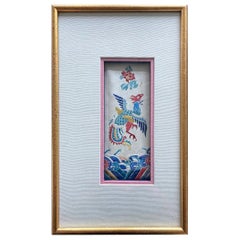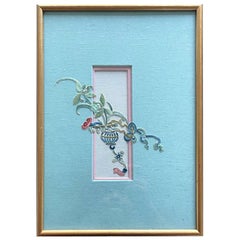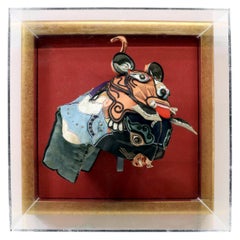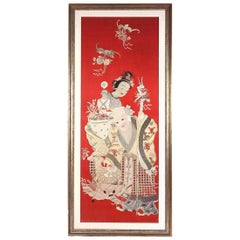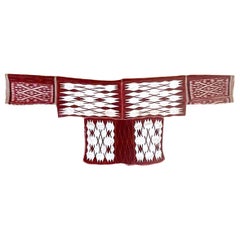TISHU Textiles
to
3
123
123
2
72
49
33
10
1
4
1
1
122
94
54
17
17
123
116
73
35
6
123
123
123
Framed Antique Embroidery Chinese Textile Qing Dynasty Provenance
Located in Atlanta, GA
A piece wonderful antique textile fragment from China, circa 19th century Qing dynasty, artistically displayed in a giltwood frame with white ...
Category
Antique 19th Century Chinese Chinese Export Textiles
Materials
Silk, Giltwood
Framed Antique Chinese Embroidery Textile Qing Dynasty Provenance
Located in Atlanta, GA
A piece of beautiful antique textile fragments from China, circa 19th century Qing dynasty, artistically displayed in a giltwood frame with contrasting teal blue color cloth matts. O...
Category
Antique 19th Century Chinese Chinese Export Textiles
Materials
Silk, Giltwood
Framed Antique Chinese Child Tiger-Head Hat
Located in Atlanta, GA
This lovely textile art was from Central-Northern China circa 1900s, known as "Tiger-head" hat, it was a lavishly made cotton with silk hat in form of tiger for baby boys with a wide...
Category
Early 20th Century Chinese Chinese Export Textiles
Materials
Cotton, Silk, Plexiglass, Wood
Framed Chinese Embroidery Panel of Longevity Deities
Located in Atlanta, GA
A large Chinese embroidery work of art presented in a carved gilt frame with and silver borders, circa late Qing Dynasty 19th century. The imp...
Category
Antique 19th Century Chinese Chinese Export Textiles
Materials
Silk, Wood
Framed Antique Two-Piece Chinese Embroidery Winter Jacket Ensemble
Located in Atlanta, GA
This two-piece set of Chinese antique winter coat and a neck warmer ensemble circa 19th century (late Qing dynasty) is presented in two matching giltwood shadow boxes. Tailored in light auberge silk with thick padding, the attire was reserved for cold winter weather, which was common in Northern China. The surface is masterfully adorned with embroidery of silver threads. Although the color pallet was nearly minimalistic compared to many other colorful embroidery work at the time, the contrast of silver on auberge background is visually stunning and exudes a noble air of elegance. Floral and foliage motifs are showcased in neat arrangement across the coat and ocean waves and coral rocks...
Category
Antique 19th Century Chinese Chinese Export Textiles
Materials
Giltwood, Silk
Ceremonial Cape Textile Art from Hmong Miao People
Located in Atlanta, GA
An oversized and impressive cape worn during ceremonial dancing by Miao people (also known as Hmong in English) from Guizhou Province, China circa 1940s-1950s in a rarely intact and well-preserved condition. Miao people are diverse minority groups living in Southern China as well as Southeast Asia with complex sub-affiliations based on attires, languages, cultural customs and art tradition. They are renowned for their textile and silver craftsmanship as well as singing and dancing traditions. This cape, rather heavy in construction and striking in bold red and black, was made from wool, hemp and cotton. The surface showcases elongated diamond patterns in complementary woven wool and couched plaque on top of the cotton part. The pattern strikes the viewer with a strong sense of dignity and power. The heavy material and pattern are strangely akin to some of the Navajo weaving. The cape is in a form a jacket with long and wide sleeves, and it was meant to be used in ceremonial occasions.
Our research reveals that the piece was from the Northwest Guizhou in an autonomous county called Weining. The area is of subtropical highland and the generally cold weather was reflected in the heavy materials used in this piece, in comparison with other textiles made in the warmer lowland.
There is an older paper label with price tag in Chinese inside the cape. It was purchased in Guizhou decades ago by a US collection in MA. With a span of over 94 inches long, it makes a very impressive textile art piece for wall hanging. Not framed and easily shipping folded up.
For a similar jacket from Weining, see "Miao Textile...
Category
Mid-20th Century Chinese Tribal Textiles
Materials
Textile
Antique Brocade Kesa Monk's Patched Robe Edo Period
Located in Atlanta, GA
Kesa, known as "Jiasha" in Chinese and "Kasaya" in Sanskrit, is an out layer garment worn by the ordained Buddhist monks. Bearing a basic rectangular form, it developed originally in...
Category
Antique Late 18th Century Japanese Edo Textiles
Materials
Textile, Brocade
Antique Japanese Textile Art Campaign Jacket Jinbaori with Mon
Located in Atlanta, GA
Known as Jinabori during 16th century when warfare was common in feudal Japan, the sleeveless jacket was created to be worn outside of the armor by samurai warriors. In addition to s...
Category
Antique 19th Century Japanese Japonisme Textiles
Materials
Textile, Silk
Framed Japanese Antique Phoenix Dragon Embroidery Tapestry Meiji Period
Located in Atlanta, GA
A visually stunning Japanese embroidery tapestry circa 1890s-1900s late Meiji period, presented with a linen matt with gold trim in a gilt wood frame. The design showcases a flying p...
Category
Antique 1890s Japanese Japonisme Textiles
Materials
Silk, Giltwood
Framed Japanese Relief Embroidery Textile Art of Dragon
Located in Atlanta, GA
A beautiful Japanese textile art panel with an embroidered dragon on a swirling cloud background, nicely framed with a linen matt in an antique-fi...
Category
Antique 1890s Japanese Japonisme Textiles
Materials
Silk, Wood
Pair of Framed Japanese Embroidery Art Portraits
Located in Atlanta, GA
Artistically framed for display in a slight shadow frame with non-reflective pixie glass, these pair of embroidery art panels from Japan are dated circa 1910-1930s, end of Meiji to early Taisho period. This period was the peak of the Japanese oversea expositions, when all things Japonisme took Europe and America by storm and left long-lasting impact on western art and design. The influence, however, was clearly not one-directional; As when Japanese artists, artisans and dealers experienced western art, it in turn inspired and impacted on the aesthetics of the Japanese art made for the western tastes. An interesting crop of art forms quickly emerged with a particular outlook that bridged the east and west, with the fundamental techniques still rooted in Japanese traditions. These rare hyper-realistic embroidered portraits were such an example. They took the essential format of the western portrait that permeated the Victoria and Edwardian Society, but substituted with exotic Japanese subjects and executed in traditional embroidery techniques which had been perfected for centuries by the natives.
The two portraits on offer, one an elder man with long white beards and a pair of round spectacles lighting a pipe, and the other a grinning man with a peasant attire, were both set in black background, stimulating an appearance of Classic western oil painting or perhaps even the photograph. The fine stiches were maneuvered into an impressively hyper-realistic imagery that was far removed from the traditional Japanese embroidery...
Category
Early 20th Century Japanese Japonisme Textiles
Materials
Silk, Wood
$6,000 / set
Framed Japanese Futon Cover Textile Art with Resist Yuzen Dye
Located in Atlanta, GA
A large piece of framed Japanese textile circa late 19th to early 20th century, end of Meiji period. Seamed together from four vertical sectio...
Category
Early 20th Century Japanese Meiji Textiles
Materials
Cotton, Wood
Framed Japanese Embroidery Textile Panel Rootsters
Located in Atlanta, GA
A matted and framed Japanese silk panel with elaborate embroidery circa late Meiji to Taisho period (1910-30s). On a bright background, two rooster...
Category
Early 20th Century Japanese Japonisme Textiles
Materials
Silk, Wood
Framed Antique Japanese Silk Embroidery Fukusa Textile Panel
Located in Atlanta, GA
A Japanese Fukusa Panel with tassels displayed in a gilt frame circa Meiji Period. Fukusa is a traditional Japanese textile art used as a...
Category
Antique Late 19th Century Japanese Meiji Textiles
Materials
Silk, Wood
Antique Japanese Export Silk Embroidery Panel of American Union
Located in Atlanta, GA
A rather fascinating silk embroidery panel that depicts an American eagle perched on a shield, with laurel branches and shooting arrows under the...
Category
Antique Late 19th Century Japanese Japonisme Textiles
Materials
Silk, Wood
Japanese Fukusa Relief Embroidery Textile Art of Dragon
Located in Atlanta, GA
A visually stunning Japanese fukusa panel with an embroidered dragon on a swirling cloud background, nicely displayed on a scarlet felt matt in a carve...
Category
Antique 1890s Japanese Japonisme Textiles
Materials
Silk, Wood
Framed Japanese Oshi-E Textile Art Meiji Period
Located in Atlanta, GA
On offer is the last one of the set of seven framed Japanese textile art called Oshi-E circa Meiji Period (1868-1912). This rare set consists ...
Category
Antique 1890s Japanese Japonisme Textiles
Materials
Giltwood, Silk
Antique Japanese Export Silk Embroidery Americana Patriotic Panel
Located in Atlanta, GA
A silk embroidery panel that depicts an American eagle perched on the liberty shield, with laurel branches and shooting arrows under the feet and flanked by four American flags and b...
Category
Antique Late 19th Century Japanese Japonisme Textiles
Materials
Silk, Wood
Japanese Antique Textile Panel of American Historical Great White Fleet
Located in Atlanta, GA
Nicknamed Great White Fleet, the sailing of the United States Navy battleships around the globe from December 16, 1907 to February 22, 1909 by order of Uni...
Category
Antique Early 1900s Japanese Japonisme Textiles
Materials
Brocade, Silk, Wood
Frame Antique Chinese Embroidered Robe Qing Dynasty
Located in Atlanta, GA
A woman's coat made of black silk with wide sleeves from Chinese late Qing Dynasty (mid to late 19th century), mounted and presented on blue linen board and framed as a stunning piec...
Category
Antique 19th Century Chinese Chinese Export Textiles
Materials
Silk, Giltwood
Vintage Japanese Silk Meisen Kimono with Geometrical Design
Located in Atlanta, GA
A vintage Japanese formal silk Kimono in an "ink green" color with striking geometrical design. The garment is hand-stitched Meisen kimono from a crepe l...
Category
Mid-20th Century Japanese Japonisme Textiles
Materials
Silk
Vintage Cloud Design Batik from Java Indonesia
Located in Atlanta, GA
Probably one of the most beautiful batik textile designs from Indonesia, the wraparound skirt also known as Kain Panjang was an iconic design from Cirebon, North Coast of Java. The Cloud design...
Category
Mid-20th Century Indonesian Tribal Decorative Art
Materials
Textile
Collection of Five Japanese Oshi-E Textile Art Panels Meiji Period
Located in Atlanta, GA
On offer is a set of five Japanese textile art panels called Oshi-E circa Meiji Period (1868-1912). This usual set of panels depict various aspects of daily life in Edo time with beautiful details. Some of these panels are snapshots of the buzzling commercial activities at the marketplace, providing insight into the signages, architecture, costumes and how people interacted within a historical and pictorial context. Other panels depict daily leisure activities such as lounging in the park or visiting friends. The realistic rendering and attention to details are not short of "photographic" quality. From the signage of the shops to the motions and attires of the individual characters, from the hairstyle, small ornaments, down to the facial expression, were all recorded in great details. Each panel was signed with the artist's name Yukihana in Kanji with a red seal.
These panels are unframed and await your custom touch (framing with inner gilt spacer and mat costs about 250-500 depending on the material chosen, see a framed example in the last picture of a single framed panel we have for sale). We offer them for sale individually, but it will be great for a collector to consider the whole set so that they can stay together.
The Oshi-E (also known as kiritori zaiku) is a type of ornamental textile art dated back to the Muromachi period (1392-1573). It started among the elite aristocratic women in Kyoto before spreading wider in the Japanese society. Throughout Edo and Meiji period, Oshi-E were sometimes used to make offerings to the altars in the temple and in the late 19th century, it was exported to the west along with the other embroidery textile art. Oshi-E was made by using silk wadding to create a relief design. Various silk fabric swaps and sometimes wires and tassels, often recycled from older kimonos...
Category
Antique 1890s Japanese Japonisme Textiles
Materials
Silk, Giltwood
Framed Chinese Embroidery Southern Bridal Jacket
Located in Atlanta, GA
A framed vintage Chinese embroidered bridal jacket called "Gua", which is the upper part of the two-piece wedding assemble called "Qun Gua", with the low...
Category
Late 20th Century Chinese Chinese Export Textiles
Materials
Silk, Glass, Wood
Exhibited Framed Fine Chinese Embroidery Silk Panel Qing Dynasty
Located in Atlanta, GA
A very fine embroidered silk panel in giltwood frame originally from the Annette Martin Collection and exhibited at the Chinese Culture Foundation of San Francisco February 8th - Mar...
Category
Antique 19th Century Chinese Chinese Export Textiles
Materials
Silk, Giltwood
Exhibited Framed Chinese Qing Dynasty Embroidered Fifth Rank Badge
Located in Atlanta, GA
A fine embroidered silk civil rank badge panel (known in Chinese as Buzi) in giltwood frame originally from the Annette Martin Collection and exhibite...
Category
Antique 19th Century Chinese Qing Textiles
Materials
Silk, Giltwood
Japanese Woven Linen Kimono with Katazome Stencil Dyes
Located in Atlanta, GA
On offer is a Japanese summer kimono woven from indigo blue linen with ivory color fine stripes patterns with apparently darker weft additions. The elega...
Category
Early 20th Century Japanese Japonisme Textiles
Materials
Linen
Japanese Monastery Robe Patchwork Kesa with inscription Edo Period
Located in Atlanta, GA
A Japanese Kesa (Monk's Vestment) made from fourteen columns of patchworks of blue brocades with sumptuous woven pattern. The elaborate motifs feature re...
Category
Antique Early 19th Century Japanese Japonisme Textiles
Materials
Brocade, Silk
Framed Tibetan Woven Silk Kesi Panel of Kirtimukha
Located in Atlanta, GA
A woven silk Kesi panel depicts Kirtimukha from Tibet circa the second half of 20th century. Beautifully woven from short weft silk with superb coloring and ...
Category
20th Century Tibetan Tibetan Textiles
Materials
Silk
Japanese Fireman Hood with Stencil Inscription Meiji Period
Located in Atlanta, GA
A well-preserved Japanese fireman's hood (known as hikeshi zukin in Japanese) circa 1900s, late Meiji period. Woven with thick cotton with sashiko (co...
Category
Antique Early 1900s Japanese Japonisme Textiles
Materials
Cotton
Pair of Framed Chinese Embroidered Ninth Rank Badges Qing Dynasty
Located in Atlanta, GA
On offer is a matching pair of embroidered silk civil rank badge panels (known in Chinese as Buzi) in black lacquer frames. The panels feature a black background within a scrolling floral border. In the center, it showcases a winged paradise fly catcher...
Category
Antique Late 19th Century Chinese Chinoiserie Textiles
Materials
Silk, Giltwood
Framed Fine Embroidered Second Rank Badge Chinese Qing Dynasty
Located in Atlanta, GA
A finely embroidered silk civil rank badge panel presented in a giltwood frame circa mid-late 19th century. The square rank badge is known in Chinese ...
Category
Antique 19th Century Chinese Chinese Export Textiles
Materials
Silk
Framed Fine Embroidered Fifth Rank Badge Chinese Qing Dynasty
Located in Atlanta, GA
A finely embroidered silk civil rank badge panel presented in a giltwood frame circa mid-late 19th century. The square rank badge is known in Chinese ...
Category
Antique 19th Century Chinese Chinese Export Textiles
Materials
Silk
Antique Japanese Brocade Monk's Robe Kesa Meiji Period
Located in Atlanta, GA
A Japanese Kesa (Monk's Vestment) made from thirteen columns of patchworks of shimmering woven brocades. The elaborate motifs feature repetitive elaborat...
Category
Antique Late 19th Century Japanese Meiji Textiles
Materials
Brocade, Silk
Fine Korean Embroidered Military Rank Badge Joseon Dynasty One of the Pair
Located in Atlanta, GA
A Korean embroidered silk rank badge (Hyungbae in Korean) from late Joseon Dynasty circa t19th century. One of a fine matching pair, the badge featu...
Category
Antique 19th Century Korean Other Textiles
Materials
Fabric, Silk, Wood
Fine Korean Embroidered Military Rank Badge Joseon Dynasty One of the Pair
Located in Atlanta, GA
A Korean embroidered silk rank badge (Hyungbae in Korean) from late Joseon Dynasty circa t19th century. One of a fine matching pair, the badge features des...
Category
Antique 19th Century Korean Other Textiles
Materials
Fabric, Silk, Wood
Korean Embroidered Military Rank Badge Joseon Dynasty
Located in Atlanta, GA
A Korean embroidered silk rank badge (Hyungbae in Korean) from late Joseon Dynasty circa the end of 19th century. The badge features a design of double leop...
Category
Antique Late 19th Century Korean Other Textiles
Materials
Fabric, Silk, Wood
Framed Antique Japanese Embroidery Fukusa Panel
Located in Atlanta, GA
A finely embroidered Japanese silk Fukusa panel presented in a beautiful brocade-wrapped fame. Circa late 19th century of Meiji Period, Fukusa is a traditional Japanese textile...
Category
Antique Late 19th Century Japanese Meiji Textiles
Materials
Silk, Wood
Japanese Brocade Noh Costume Kimono Robe Meiji Period
Located in Atlanta, GA
A Noh costume made from magnificent silk twill brocade woven with metallic gold threads circa 1930s. The robe is identified as "Atsuita", made for male actors in the Noh play. The luxuriant fabric has a deep blue background with golden interlocking hexagon pattern that resembles tortoise shells, the symbol of longevity. The motifs showcase three auspicious symbols in repetitive patterns: roundels of coiled dragon, phoenix and peony. The kimono robe...
Category
20th Century Japanese Meiji Textiles
Materials
Brocade, Silk
Framed Chinese Embroidered Silk Collar Qing Dynasty
Located in Atlanta, GA
An embroidered silk collar from China dated to late Qing Dynasty circa 19th century. Known as Yunjian (Cloud Shoulder or Cloud Collar), this multi-lobed t...
Category
Antique Early 19th Century Chinese Qing Textiles
Materials
Silk
Framed Chinese Embroidered and Appliqued Silk Collar Qing Dynasty
Located in Atlanta, GA
A silk collar from China dated to late Qing Dynasty circa 19th century. Known as Yunjian (Cloud Shoulder or Cloud Collar), this multi-lobed textile piece was a detachable collar worn around the shoulders as part of the traditional Chinese garment accessory. With its origin dated back to the Han Dynasty and being used until the end of Qing Dynasty, the form evolves with time, but much of the ornamentation and fundamental symbolism remains the same.
This striking example features a two-tiered design with eight lobes on each circle, all of which are variations of the shape of auspicious "ruyi", which represents the head of Lingzhi mushroom, a symbol of longevity. The inner lobes were made with appliqued patchwork of colorful silk. The outer lobes feature elaborate embroidery of assortment of colorful flowers, scrolling ribbons and butterfly, using mostly long and short satin stitches. The borders and outlines of the designs were lineated with metallic threads buddled in chain stitches. Small black pearls were used to link the piece together and most of them still remain.
In Qing Dynasty, the silk collar with high quality was worn by noble or aristocratic women. The red color and the lotus boy symbol indicate that it was most likely part of the fashion accouterment worn during wedding ceremony.
The collar is beautifully float mounted within a double conforming mat in a giltwood frame and wood backing. A stunningly presented period piece with story to tell.
Reference: For a collection of Chinese embroidered collars...
Category
Antique Early 19th Century Chinese Qing Textiles
Materials
Silk
Framed Chinese Embroidered Silk Collar Qing Dynasty
Located in Atlanta, GA
A silk collar from China dated to late Qing Dynasty circa 19th century. Known as Yunjian (Cloud Shoulder or Cloud Collar), this multi-lobed textile piece was a detachable collar worn around the shoulders as part of the traditional Chinese garment accessory. With its origin dated back to the Han Dynasty and being used until the end of Qing Dynasty, the form evolves with time, but much of the ornamentation and fundamental symbolism remains the same.
This striking example features a two-tiered design with seven lobes on each circle, all of which are variations of the shape of auspicious "ruyi", which represents the head of Lingzhi mushroom, a symbol of longevity. The inner lobes feature elaborate embroidery floral design with long and short satin stitches. Notably, one panel has a double gourd design, the symbol of fortune. The outer lobes show a simpler but bolder vision with the outlines of the designs lineated with metallic threads buddled in chain stitches. Small jade beads were used to link the piece together and most of them still remain. The piece as a whole has a very pleasant lilac purple color, delicate with the jade beads.
In Qing Dynasty, the silk collar with high quality was worn by noble or aristocratic women. The red color and the lotus boy symbol indicate that it was most likely part of the fashion accouterment worn during wedding ceremony.
The collar is beautifully float mounted within a double conforming mat in a giltwood frame and wood backing. A stunningly presented period piece with story to tell.
Reference: For a collection of Chinese embroidered collars...
Category
Antique Early 19th Century Chinese Qing Textiles
Materials
Silk
Antique Silk Kesa Monk's Patched Robe Meiji Period
Located in Atlanta, GA
Kesa, known as "Jiasha" in Chinese and "Kasaya" in Sanskrit, is an out-layer garment worn by the ordained Buddhist monks. Bearing a basic rectangular form, it developed originally in...
Category
Antique 19th Century Japanese Meiji Textiles
Materials
Textile, Brocade
Japanese Ceremonial Brocade Jinbaori Vest Jacket
Located in Atlanta, GA
Made entirely from luxuriant woven brocade (kinran) for the exterior, this Japanese sleeveless jacket is called Jinbaori. Commonly worn by the Samurai warriors during 16th century when warfare was common in feudal Japan, this type of loose jacket, as a surcoat on top the armor, served as an extra protection, and more importantly as an identification in the battlefield with its bright colors and often Mons. In Edo period, the society was stabilized and Jinbaori gradually shifted toward a pure ceremonial function.
The jacket on offer was unusual as it was tailored entirely from the bright Chinese brocade...
Category
Antique 19th Century Japanese Meiji Textiles
Materials
Silk, Brocade
Framed Chinese Embroidered Silk Collar Qing Dynasty
Located in Atlanta, GA
An embroidered silk collar from China dated to late Qing Dynasty circa 19th century. Known as Yunjian (Cloud Shoulder or Cloud Collar).
This striking example features a two-tiered design with eleven inner and outer lobes radiating in a circular fashion. The red inner lobes feature floral embroidery design in satin stitches, the border with twisted chain stitches. The outer lobes are in the shape of auspicious "ruyi", which represents the head of Lingzhi mushroom, a symbol of longevity. Each showcases fine needlework of butterfly with spread wings and various floral motif. A small ball clasp remains on the front. This textile art is beautifully presented in a giltwood frame floating within a double mat of conforming shape.
Detachable collars such as this were worn around the shoulders as part of the traditional Chinese garment...
Category
Antique 19th Century Chinese Qing Textiles
Materials
Silk
Pair Chinese Embroidered Fourth Rank Badges Qing Dynasty
Located in Atlanta, GA
A fine matching pair of embroidered silk civil rank badge panels (known in Chinese as Buzi) unframed. The panels feature borders of fret archaic key a...
Category
Antique Mid-19th Century Chinese Qing Textiles
Materials
Silk, Giltwood
Framed Japanese Woven Textile Panel with Dragon Meiji Period
Located in Atlanta, GA
A framed Japanese woven textile circa late 19th century of Meiji Period. Likely a fragment of a priest robe or kesa, the multi-paneled textile was finely woven with gold foiled threads that depicts a five-clawed dragon slithering in the clouds and water...
Category
Antique 19th Century Japanese Meiji Textiles
Materials
Silk, Wood
Framed Chinese Qing Dynasty Embroidered Ninth Military Rank Badge
Located in Atlanta, GA
A finely embroidered silk military rank badge panel framed in a wood frame circa late Qing dynasty 19th century. The square rank badge is known in Chinese as Buzi which was displayed...
Category
Antique Late 19th Century Chinese Qing Textiles
Materials
Silk
Framed Chinese Qing Dynasty Embroidered Sixth Rank Badge
Located in Atlanta, GA
A finely embroidered silk civil rank badge panel framed in a wood frame circa late Qing dynasty 19th century. The square rank badge is known in Chinese as ...
Category
Antique Late 19th Century Chinese Qing Textiles
Materials
Silk
Elegant Vintage Japanese Silk Kimono with Shibori Band Design
Located in Atlanta, GA
A Japanese formal silk Kimono in a light blue color with striking floral design. The garment is hand-stitched from a crepe like silk and dated to circa 1940-60s. The garment is spars...
Category
Mid-20th Century Japanese Japonisme Textiles
Materials
Silk
Japanese Fisherman Festival Kimono with Tsutsugaki Design
Located in Atlanta, GA
A Japanese festival Kimono robe circa late 19th to early 20th century (end of Meiji Period) for fishing ritual. Made in a cotton fabric, the kimono was elaborately decorated by Tsuts...
Category
Early 20th Century Japanese Meiji Textiles
Materials
Cotton, Linen
Japanese Two-Piece Indigo Asa Kyogen Festival Costume Meiji Period
Located in Atlanta, GA
A two-piece Japanese festival costume based on Kyogen theater performance circa late 19th century (Meiji Period). The matching assemble consists of an oversize jacket (Suo) and a pai...
Category
Early 20th Century Japanese Meiji Textiles
Materials
Linen
Antique Japanese Noh Outer Cloak Chōken with Stencil Decoration
Located in Atlanta, GA
A large and striking Japanese outer cloak for Noh performance (known as Choken) circa 19th century (late Edo to early Meiji period). The robe was woven from a natural bast-fiber (kno...
Category
Antique 19th Century Japanese Edo Textiles
Materials
Natural Fiber
Framed Japanese Embroidery Silk Panel Meiji Period
Located in Atlanta, GA
A Japanese silk embroidery Fukusa panel presented in mat and glazed gilt wood frame circa 1890-1910s (end of Meiji Period). The blue silk pane...
Category
Antique 1890s Japanese Meiji Textiles
Materials
Silk
Rare Japanese Woven Ikat Child Kimono Nemaki
Located in Atlanta, GA
A rare and well preserved Japanese woven child's kimono circa early 20th century (end of Meiji period). The small kimono was a great example of Nemaki (...
Category
Early 20th Century Japanese Meiji Textiles
Materials
Cotton
Framed Chinese Embroidered Silk Collar Qing Dynasty
Located in Atlanta, GA
A silk collar from China dated to late Qing Dynasty circa 19th century. Known as Yunjian (Cloud Shoulder or Cloud Collar), this two-tiered, five-lobed textile piece was a detachable collar worn around the shoulders as part of the traditional Chinese garment...
Category
Antique Early 19th Century Chinese Qing Textiles
Materials
Silk
Framed Japanese Embroidery Textile Panel Meiji Period
Located in Atlanta, GA
A Japanese textile panel with embroidered picture work circa late Meiji period (1900s) presented in a gilt wood frame with silk mat. The work de...
Category
Antique Early 1900s Japanese Meiji Textiles
Materials
Silk, Wood
Framed Japanese Embroidery Textile Panel Meiji Period
Located in Atlanta, GA
A Japanese textile panel with embroidery needlework circa late Meiji period (1900s) presented in a gilt wood frame with silk mat. The work depic...
Category
Antique Early 1900s Japanese Meiji Textiles
Materials
Silk, Wood
Framed Antique Japanese Embroidery Fukusa Textile Panel
Located in Atlanta, GA
A Japanese silk Fukusa Panel housed in a gilt frame circa late 19th century of Meiji Period. Fukusa is a traditional Japanese textile art used as a wrap for presenting gifts at important occasions. On the deep blue background, the elaborate embroidery work depicts a historical scene where street vendors selling goods to a royal household or an aristocratic residence. The scene focuses on the activities at the front gate where the couriers and servants were busying carrying the goods in. A peasant with straw coat...
Category
Antique Late 19th Century Japanese Meiji Textiles
Materials
Silk, Wood
Vintage Japanese Gauze Kimono with Embroidery Modern Design
Located in Atlanta, GA
A Japanese formal Kimono made with a very fine black linen gauze augmented with applied modern circle pattern. The garment was hand-stitched and dated to circa 1930-50s. The black ga...
Category
Mid-20th Century Japanese Japonisme Textiles
Materials
Silk, Linen
